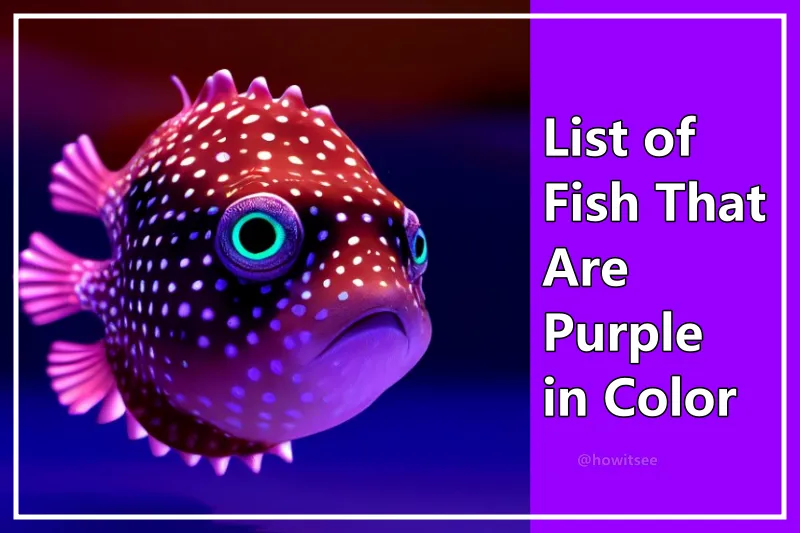There is a vast selection of Fish to pick from, some of the most eye-catching of which have a vivid violet tinge. If you love fish and are interested in the variety of Fish, you might wonder if purple fish exists.
Many different kinds of fish are surprisingly purple. The overwhelming majority agree that you should! Fifteen species of purple fish are discussed in this article, from the most common to the rarest.
Let’s dive right into the article.
Please note that the are many key requirements and water conditions of aquariums for different fishes. So, always look into the factors mentioned below before petting any fish.
- Water Temperature
- Tank Size
- Light
- Environment
- Rocks
- Water pH
- Water Hardness (dGH)
- Ammonia and nitrites
- Nitrates
- Diet
Are There Any Purple Fish?
Many different kinds of fish can be found in purple. Some betta fish species, for instance, have purple tones in their scales, while the royal gramma, a Caribbean reef fish, has a unique purple and yellow pattern on its body.
Some angelfish, wrasses, and anthias have this coloration as well. It’s important to keep in mind that different species might display varying degrees of purple, with some looking more blue or pink than true purple.
Many different kinds of fish can be found in purple, including:
- Betta fish: The scales of several betta fish species are purple.
- Royal Gramma: The Caribbean is home to this reef fish, easily identified by its purple and yellow coloring.
- Anthias: The purple queen anthias and the lyretail anthias are only two examples of the many species of anthias that feature purple colors.
- Angelfish: The emperor’s angelfish blue and purple coloring makes it instantly recognizable.
- Wrasse: The purple wrasse is a Pacific Ocean fish that is uniquely colored purple.
20 Beautiful Purple Fish
1. Purple Tang
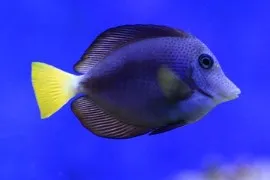
| Scientific Name | Zebrasoma xanthurum |
| Size | ~25 cm |
| Life Expectancy | 30-45 years |
| Est. Price | $259.99-$449.99 |
The most popular aquarium fish that is purple in color is Purple Tang. It displays a range of colors from blue to purple, with a distinctive yellow tail and accents on its pectoral fins.
They are mostly found in the coral reefs of the Red Sea, the Arabian Sea, and the Gulf of Aden. They can grow upto 10 inches from head to tail. They predominately feed on Sea Veggies, Seaweed Salad, and Ocean Nutrition.
2. Purple Velvet Wrasse
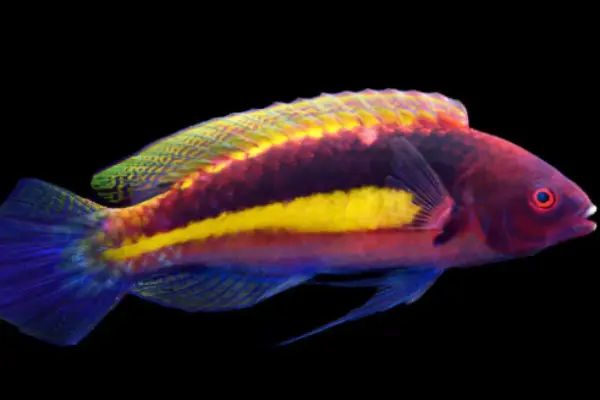
| Scientific Name | Cirrhilabrus luteovittatus |
| Size | 8.8-11.45 cm |
| Life Expectancy | 1-2 years |
| Est. Price | $80-$150 |
The Purple Velvet Wrasse (Cirrhilabrus luteovittatus) is a peaceful fish from the West Pacific Ocean. It thrives in lagoons and channels with coral or macroalgae, typically at depths exceeding 45 feet.
Males exhibit maroon coloration with a yellow stripe, while females display olive and purple hues. They require a moderate care level and a tank size of at least 55 gallons
. Acclimating adult males can be challenging, and they should be provided with ample swimming space. Avoid housing two males together, as aggression may arise.
3. Masked Grouper
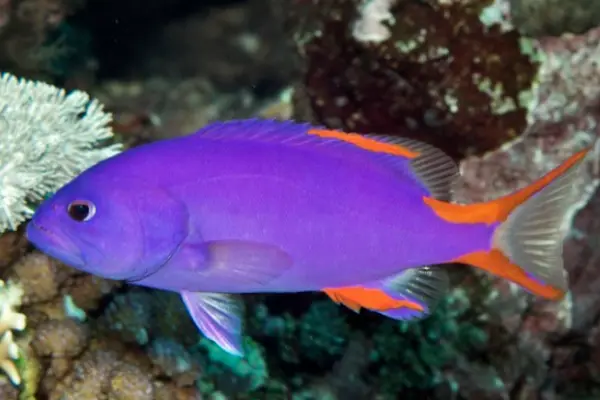
| Scientific Name | Gracila albomarginata |
| Size | <45 cm |
| Life Expectancy | 30-50 years |
| Est. Price | $400-$500 |
Masked Grouper has various names, “thinspine grouper, rededged cod, red-edged grouper, slenderspine grouper, thinspine rockcod, white-margined grouper, white-square cod or white-square grouper.”
These fish have purplish-brown base hue with the patterns of rusty red, green, blue and other colors. Masked Grouper can be easily found in the Indo-Pacific, from northern Mozambique north to Kenya east to French Polynesia and the northern Great Barrier Reef. They mainly feed on small fishes.
4. Purple Firefish
| Scientific Name | Nemateleotris decora |
| Size | 9 cm (maximum) |
| Life Expectancy | 18-36 months |
| Est. Price | $89.99-$200 |
Elegant Firefish, also known as Purple firefish, is another one of the most beautiful fish with purple head and longitudinal bands and yellowish body with red fins.
These fish are widely popular for being resistance to disease. They mostly feed on zooplankton, especially the larvae of copepods and crustaceans.
5. Magenta Dottyback
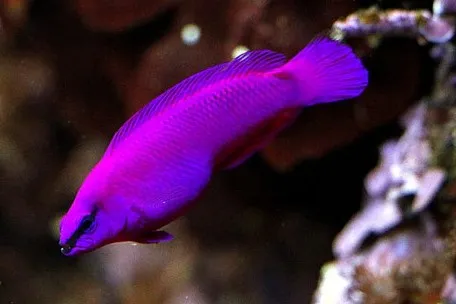
| Scientific Name | Pictichromis porphyrea |
| Size | 6-10 cm |
| Life Expectancy | 5-7 years |
| Est. Price | $24-$150 |
One species of dottyback fish found in the western Pacific is called the magenta dottyback.
It can be seen from the Philippines to Samoa, including the Ryukyu Islands to the north and the Moluccas and Admiralty Islands to the south.
There have been reports of it showing up in aquarium stores. It can reach a length of 6-10 cm as it matures.
6. Purple Queen Anthias
| Scientific Name | Pseudanthias tuka |
| Size | 12-16 cm |
| Life Expectancy | ~3 years |
| Est. Price | $44.99-$3,499.00 (depending on various factors) |
Purple Queen Anthias are tough fish and can be very difficult to keep in captivity. They require a specific set of conditions in order to thrive, and even then, many do not survive. Most of the fish don’t eat food and die from starvation.
If you are considering keeping a Purple Queen Anthias, it is important to do your research and make sure that you have the right setup like a large tank with fast-moving water, shade from the lights, a group of one male and several females.
7. Purple Harlequin Rasbora
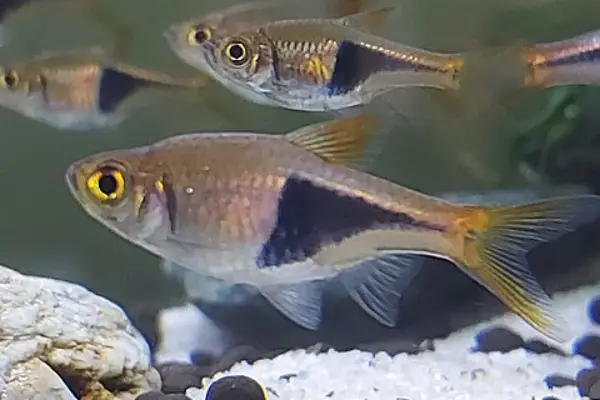
| Scientific Name | Trigonostigma heteromorpha |
| Size | 3.5-4.5 cm |
| Life Expectancy | 5-8 years |
| Est. Price | $5.99-$16.99 |
The Purple Harlequin Rasbora is a attractive and peaceful fish that is perfect for nano aquariums. It is characterized by its striking purple coloration, which is especially noticeable when paired with dark-colored substrate.
Males have more vibrant colors and pointed markings, while females are rounder in shape. These fish are omnivore and mainly feed fish flakes or pellets
8. Purple Chromis
| Scientific Name | Chromis scotti |
| Size | 8-10 cm |
| Life Expectancy | 8-15 years |
| Est. Price | >$20 |
Groups of Purple Chromis (Chromis scotti) can be seen swimming in and around reefs in the western Atlantic and the Caribbean. Young Purple Chromis are primarily blue and purple in hue, with bright purple highlights around the eyes and forehead.
Once fully mature, their bodies take on a grayish hue that fades to white underneath and is accented by vivid purple and blue markings on the fins and around the eyes.
Groups of three or four Purple Chromis, or a combination of Purple Chromis and other Chromis species, is ideal. They are sometimes aggressive among one another but usually amicable toward tankmates of different species.
9. Purple Peacock Cichlid
| Scientific Name | Aulonocara Stuartgranti |
| Size | 8 to 20 cm |
| Life Expectancy | 6 to 10 years |
| Est. Price | $10-$60 |
Let’s end the list of purple fish with Purple Peacock Cichlid that is endemic to Lake Malawi in East African Rift. These fish are very beautiful having purple-blue-violet color patterns withs yellow-tipped tail, which both males and females possess. They are not aggressive towards other fish and mainly feed on small fish or insects.
10. Royal Gramma Basslet
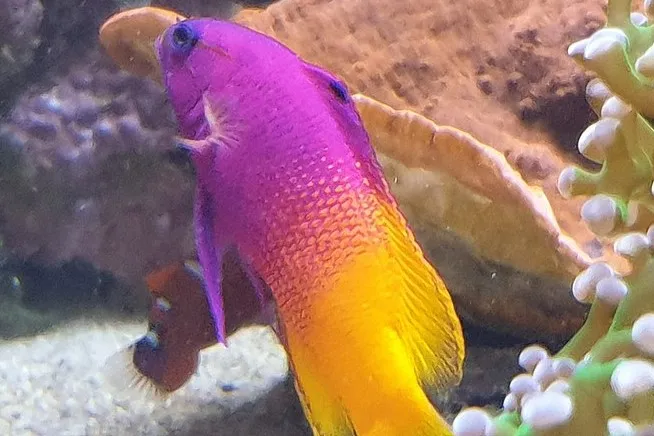
| Scientific Name | Gramma loreto |
| Size | ~7.62 cm |
| Life Expectancy | 5-6 years |
| Est. Price | ~$149.99 |
The Royal Gramma Basslet is a colorful fish that is popular among saltwater aquarium hobbyists. It is native to the Caribbean Sea and is known for its vibrant purple and yellow coloration.
Royal Gramma Basslets are relatively small, typically reaching only 3-4 inches in length. They are also relatively peaceful fish, making them a good choice for nano reef systems. They feed on a varied diet including: plankton, crustacean flesh, mysid, brine shrimp, and other quality sea food.
11. Purple Emperor Tetra
| Scientific Name | Inpaichthys kerri |
| Size | < 4cm |
| Life Expectancy | 5-6 years |
| Est. Price | $7-$13 |
The Purple Emperor Tetra is a peaceful and active fish that naturally forms shoals and can be easily available with minimum price range.
They are sometimes accused of fin-nipping, but this behavior can be prevented by keeping them in groups of 10 or more individuals and providing enough visual barriers in the aquarium.
This will make the fish feel more secure and reduce aggression between males. Males have a light purplish-blue body with a dark blue stripe, elongated dorsal fin, and blue adipose fin. Females have a reddish orangy-brown adipose fin and distinct coloration.
12. Purple Moscow Guppy
| Scientific Name | Poecilia reticulata var. |
| Size | 1.524-3.556 cm |
| Life Expectancy | 2-5 years |
| Est. Price | $40-$100 |
Purple Moscow Guppies or we can say Purple Guppies, are beautiful aquarium fish ranging from $40 to $100, depending on their strain. These fish was originated through selective breeding in Russia in the late 80’s.
They have dark purple body with shinning metallic green and blue patterns. They are omnivores and feed nearly edible item from frozen food to pellets. Water conditions for Purple Moscow Guppies are:
- Water Temperature: 74 °F (23 °C)
- Water pH: 7.5
- Water Hardness (dGH): 10
- Ammonia and nitrites: 0 ppm
- Nitrates: 10 ppm maximum
13. Orchid Dottyback
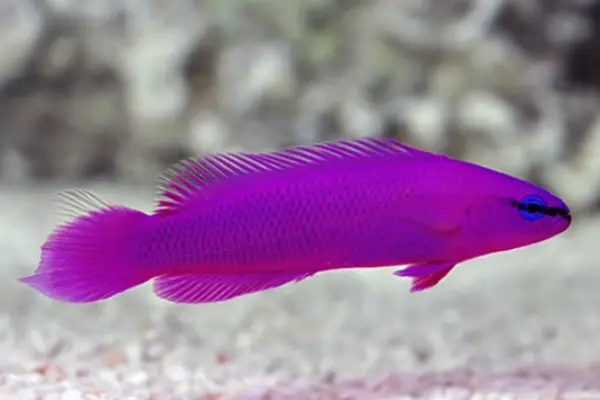
| Scientific Name | Pseudochromis fridmani |
| Size | 7cm (maximum) |
| Life Expectancy | 5-7 years |
| Est. Price | $60-$150 |
Orchid Dottyback, also known as Fridman’s Dottyback is a beautiful lavender fish that is native to the Red Sea. It is a popular addition to reef tanks because it is easy to care for and has a charming personality.
The dottyback is a territorial fish, and preys on pests such as small mantis shrimp and bristleworms. These fish can be easily available with low prices.
14. Purple-Brown Parrotfish
| Scientific Name | Scarus fuscopurpureus |
| Size | 3.8 cm |
| Life Expectancy | 5-7 years |
| Est. Price | No data |
The maximum length for a Scarus fuscopurpureus is 38 mm (1.5 inches). The sexes and developmental stages of these fishes determine their color patterns. They can be brown, green, or blue with a single white vertical stripe and white along the edges of their scales.
The juvenile has a truncate to emarginated caudal fin and a mix of light and purple-brown (thus the common name) bands on its body.
There is some evidence that males in the terminal phase have a yellow band below their soft dorsal and a yellow rim around their lunate tail.
15. Ornate Boxfish
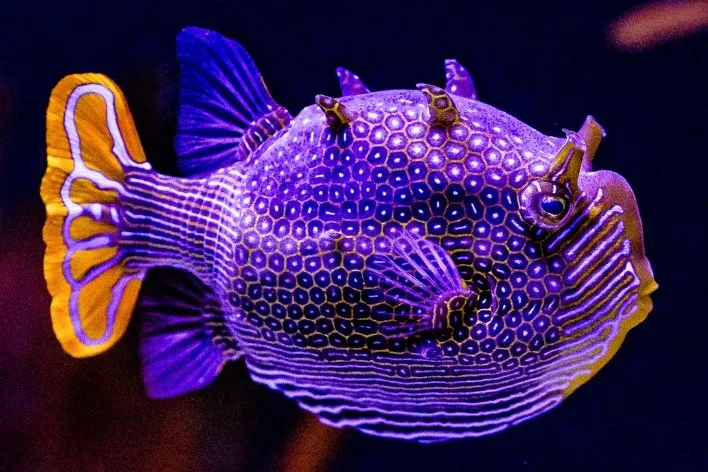
| Scientific Name | Aracana ognata |
| Size | >15 cm |
| Life Expectancy | 3-4 years |
| Est. Price | $100+ |
The subtropical and temperate zones of Southern Australia are home to the ornate boxfish range.
68°F to 75°F (20°C to 24°C) sea with rocky reefs and protected bays characterize this region. The ornate boxfish is a deep-sea fish that can be found at depths of up to 60 meters (196 ft).
Males and females of this species appear differently due to sexual dimorphism. The males of this species are the most significant and most elaborately marked. Females are delicately striped and significantly smaller than males.
16. Jack Dempsey
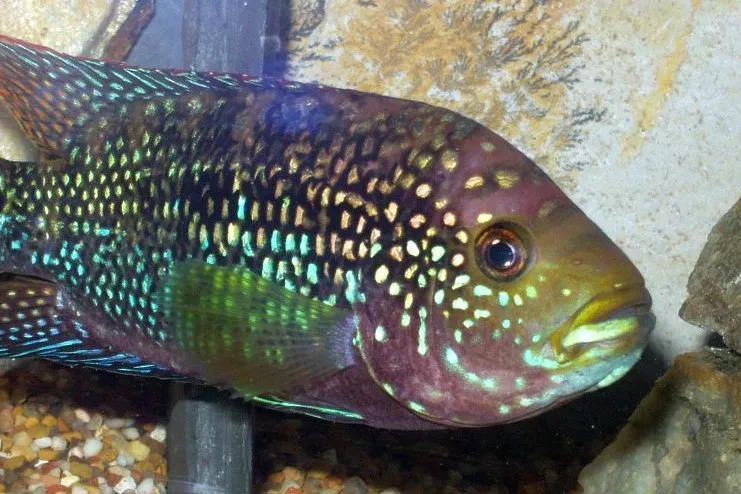
| Scientific Name | Rocio octofasciata |
| Size | 20-30 cm |
| Life Expectancy | 10+ years |
| Est. Price | $139+ |
They have iridescent dots that can be blue, purple, green, or gold in hue. Wherever they go, their spots shine in the light.
Despite their difficulties, they are beloved by so many people because of their glitter! Their carnivorous diet consists primarily of bony fish but includes shrimps.
17. Purple Puffer Fish
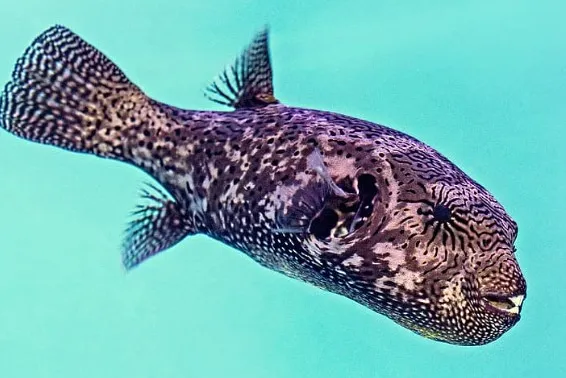
| Scientific Name |
Takifugu porphyreus |
| Size | 30-50 cm |
| Life Expectancy | up to 10 years |
| Est. Price | No data |
It belongs to the family Tetraodontidae and is commonly referred to as the purple puffer. Its original range extends from Hokkaido to the East China Sea in the Northwest Pacific.
The total length of this demersal species, which lives in the coastal zone, is 52 centimeters (20.5 inches). Even though several sections of this fish are highly poisonous, it is a popular fugu in Japan.
18. Purple Masked Angelfish
| Scientific Name | Centropyge venustus |
| Size | <12 cm |
| Life Expectancy | up to 6 years |
| Est. Price | $190-$200 |
Purple Masked Angelfish, commonly known as Venustus Angel or Blue-backed Angelfish have magnificient contrast of bluish-purple and yellow hues. These are beautiful and hardy fish that can make a great addition to your saltwater aquarium.
They feed on varied diet that includes both plant and animal matter, including spirulina, marine algae, mysis shrimp, frozen shrimp, and other meaty items.
Here are some key requirements for Purple Masked Angelfish.
- Tank size > 70 gallons
- Live rocks should be there
- Choose different fish of similar size.
- Maintain good water quality & moderate lighting
19. Purple Surgeonfish
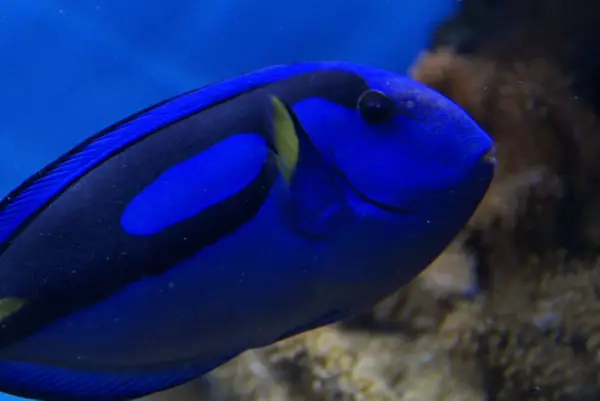
| Scientific Name | Acanthurus xanthopterus |
| Size | up to 60 cm |
| Life Expectancy | 30-45 years |
| Est. Price | $120-$150 |
The first poisonous fish on our list is Purple Surgeonfish. They are commonly known as Cuvier’s Surgeonfish, Purple Surgeonfish, Ring-Tailed Surgeonfish, Yellowfin Surgeonfish. These fish are not suitable for hometanks becuase of being poisonous. Purple surgeon fish are greenish-blue in color with a purple tail and green fins.
20. Parrot Cichlid– PURPLE JELLYBEAN
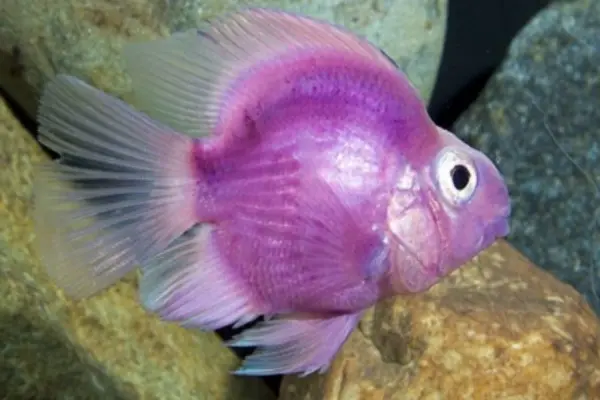
| Scientific Name | Amphilophus labiatus x Heros severus |
| Size | 7-20 cm |
| Life Expectancy | 10 to 15 years |
| Est. Price | ~$29.00 |
Parrot Cichlid– PURPLE JELLYBEAN is a man-made hybrid of two species, “Amphilophus labiatus” & “Heros severus”. It’s origin is unknown. These fish are complete purple with grey tail and fins. They can grown up to 20 cm and have the lifespan of 15 years. They feed on all kinds of live, fresh, and flake foods.
In conclusion, if you’re looking to add a stunning burst of color to your aquarium, purple fish are an excellent choice. The 15 species showcased in this article represent some of the most beautiful purple fish available for aquarium enthusiasts.
From the majestic Purple Tang to the captivating Purple Harlequin Rasbora, these fish bring vibrancy and elegance to any aquatic setup. Remember to provide them with suitable tank conditions, appropriate tank mates, and a balanced diet to ensure their well-being and showcase their full beauty.
Whether you have a large reef tank or a small nano setup, there’s a purple fish waiting to transform your aquarium into a mesmerizing underwater world. So, dive into the world of purple fish and create a captivating aquatic masterpiece right in the comfort of your own home.
Here, we conclude our article on “List of Fish That Are Purple in Color.” We hope you like our post. We will be back with another exciting article. Till then, stay tuned with us.
References:
- Wikipedia
- 7 freshwater purple fish to liven up your aquarium by AZanimals
- Pink and purple saltwater fish by tfhmagazine
Also Read:

A writer who studied agriculture. Nature has always drawn me in, and my main goal in writing about it is to discover some of its secrets. You can usually find me reading Bengali and English masterpieces or filling the room with lovely music if I’m not engrossed in nature or anime material. I adore playing the guitar. I’m also that friend of yours who enjoys playing video games.
